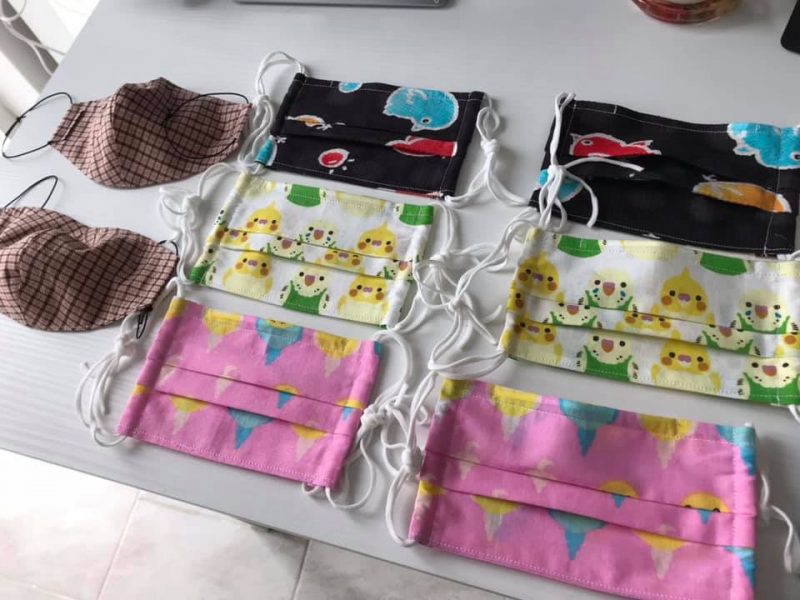Apr 30, 2020
Make Your Mask Jazzy and Japanese!
While the rush on toilet roll seems to have abated, there is one thing, in these corona-stricken times, that you can’t get your hands on for love nor money, and that’s masks. Although the WHO has advised that the wearing of masks will do little to protect the wearer from catching COVID-19, they are useful in preventing those who are infected – whether symptomatic or otherwise – from spreading the virus, advice backed up by the CDC and Oxford University professors.
Of course, here in Japan we are very much used to wearing and seeing people wear masks, but right from the outbreak, it seemed people started hoarding them, to the extent that their sale is now restricted and queues of people waiting outside of pharmacies each morning have become a common sight.
And so, if you wish to follow the guidelines in keeping others safe in the event that you are carrying COVID-19, you may be thinking of making your own mask, and are ransacking your drawers for old t-shirts. But do you really want to be seen with that faded Fruit of the Loom, or that top that says ‘My Friend Went to [Insert Tacky Holiday Spot Here] and All I Got Was This Lousy T-Shirt’ emblazoned across your chops? Of course, you don’t.
No, what you want is something that stands out a little bit. So why not get some jazzy Japanese material with which to make your mask?
Furoshiki
Furoshiki are a type of Japanese wrapping cloth traditionally used to transport clothes, gifts, or other goods. And while these are usually used in bag form (and also make great gifts and souvenirs), they are generally of the perfect design to make your funky masks.

You can find furoshiki at pretty any tourism gift or souvenir shop, but if you want to find really good quality at relatively decent prices (gift shop goods, in general, can be overpriced) head to the 11th floor of the Takashima department store in Nagoya Station. You can find a wide array of beautiful fabrics just past the birthday cards in Tokyu Hands.
Where: Meieki, 1 Chome-1-4 JR Nagoya Takashimaya 11F (map)
Tenugui
Tenugui are thin Japanese hand towels made from cotton often used as headbands, souvenirs and decorations. Generally measuring 90 x 30 cm, they are the ideal size to make three masks each.

You can find cheap tenugui on Amazon or, like the furoshiki, they can be picked up in pretty much any souvenir shop – the gift store in Nagoya Station has some pretty cool ones with Nagoya Castle on. However, if you want to be really flash and super traditional, make your way down to Arimatsu, where some of the most exquisite tie-dye fabrics in Japan can be found.
Where: Arimatsu, Midori Ward, Nagoya (map)
Kimono
If you really want to stand out and get tongues wagging, making your mask out of kimono fabric will really do the job. There is nothing so cool and original as the cloth of the traditional Japanese dress, and there are so many different patterns to choose from.

The problem with using kimono is that it can be pretty costly – and perhaps wasteful – to purchase a kimono just to dismantle it. However, Komehyo in the Osu shopping arcade has an entire store dedicated to second-hand kimono that are incredibly cheap (in some cases comparable to furoshiki). They also sell the fabric by length, so you can often get as much or little as you require. If you don’t find what you are looking for there, there are plenty of second-hand stores in the area.
Where: 2 Chome-19-36 Ōsu, Naka Ward (map)
Make your own mask
There are a number of websites instructing you on how to make your own fabric mask. Here are a few ideas.
https://www.cdc.gov/coronavirus/2019-ncov/prevent-getting-sick/diy-cloth-face-coverings.html
https://www.theguardian.com/us-news/2020/apr/06/how-to-make-no-sew-face-mask-coronavirus
https://www.goodhousekeeping.com/health/a31902442/how-to-make-medical-face-masks/
https://www.cnet.com/how-to/make-a-coronavirus-face-mask-or-covering-at-home-what-to-know/
Image by Mizuho Tabuchi via Facebook.com [With Permission] – Modified
Image by ShanoPics via flickr.com [CC BY NC-ND 2.0] – Modified
Image by sekihan via flickr.com [CC BY NC-ND 2.0] – Modified
Image by Simon Q via flickr.com [CC BY NC-ND 2.0] – Modified


About the author